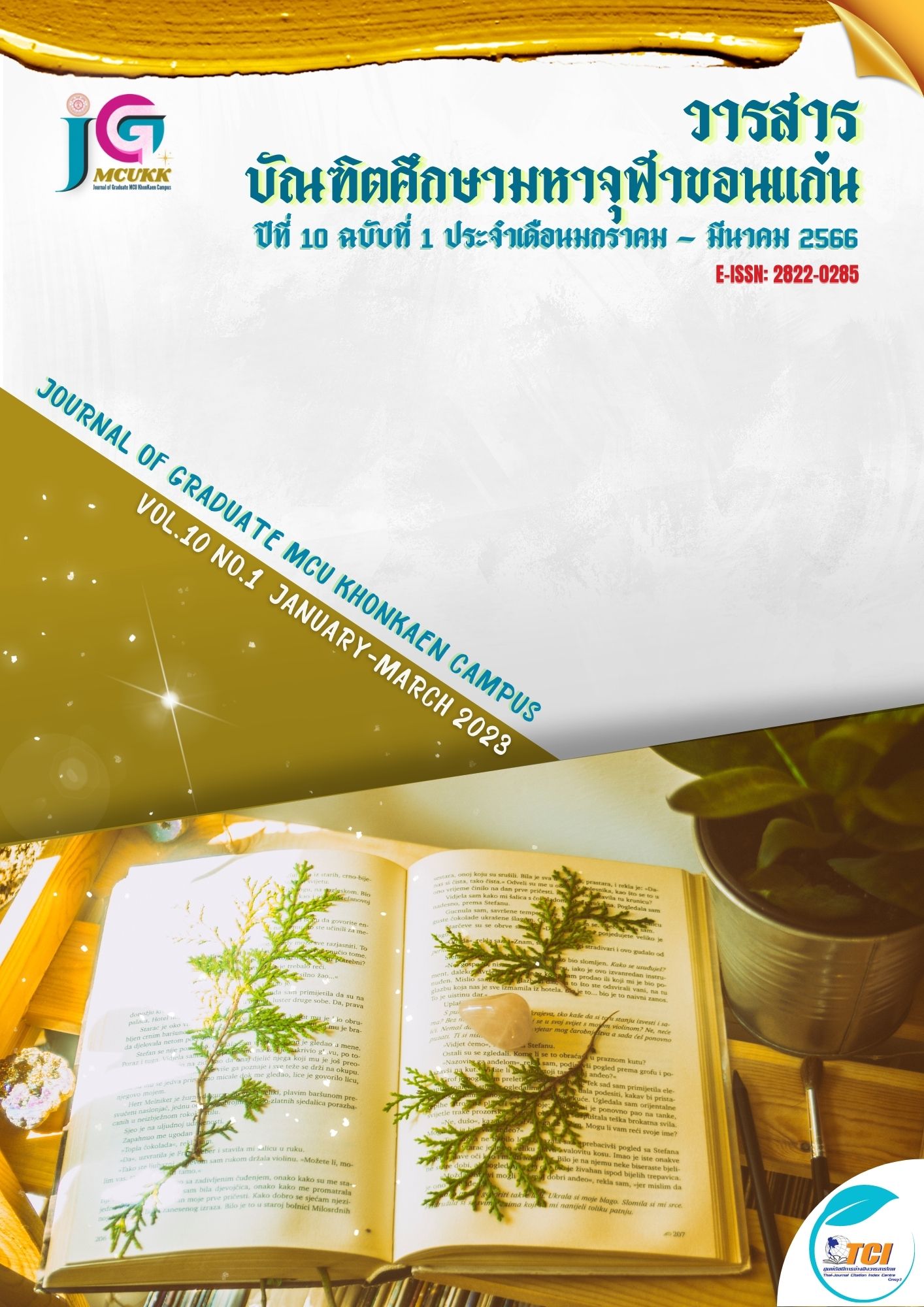The Study of Occupational Therapy Administration Guideline in a Special Education Center in Chiang Rai Province
Main Article Content
Abstract
The objectives of this research were 1) to study the current state of occupational therapy administration in a special education center in Chiang Rai province 2) to develop occupational therapy administration guidelines in a special education center in Chiang rai province .The sample group consisted of 210 people Consists of school administrators, Teachers and educational personnel in a special education center in Chiang Rai province and parents of students in a special education center in Chiang Rai province. The research tools were a questionnaire on the current state of occupational therapy administration. There were a index of item objective congruence equal to 0.86 and reliability (Cronbach's alpha coefficient) with a confidence level of the questionnaire equal to 0.95 and a semi-structured interview on occupational therapy administration guidelines in a special education center in Chiang rai province. Statistics used in data analysis were percentage, mean and standard deviation.
The findings of this study were as follows :
- Current state of administration of occupational therapy in a special education center in Chiang Rai province .It consists of 4 components: 1. Service 2. Management 3. Academic 4. Other performance . The Overall opinions were at a high level. When considering each side, it was found that the opinions were at a high level. In order of average, they were academic (
=4.31), services (
=4.30), other performance (
=4.01), and management (
=4.01). Moderate was moderate (
=3.46).
- Occupational Therapy administration Guidelines in a special Education center in Chiang rai. 2.1 Service : There is a systematic planning of the process of service activities. And there is supervision and follow-up from executives and department heads. 2.2 Management: Participate in setting goals, visions and missions of educational institutions. An occupational therapy practice manual has been prepared. There is an appropriate, clean, safe occupational therapy service location. There is a summary of annual report information that is clear, accurate and up-to-date. There is supervision and follow-up from executives and department heads. 2.3 Academic : Develop educational institutes' curriculum and develop a draft occupational therapy curriculum that is consistent with the context of the educational institution, providing information and knowledge to teachers, educational personnel and other relevant personnel. To create understanding and guidelines for helping children with special needs. Continuous self-development and professional development which will be beneficial for work development There is supervision and follow-up from executives and department heads. 2.4 Other performance: Create a clear understanding and agreement with occupational therapy teachers on duties other than providing occupational therapy services. therefore, there are a plan, organized calendar of operations. Supervision and follow-up from executives and department heads Summarize and evaluate performance to develop, improve and continue.
Article Details

This work is licensed under a Creative Commons Attribution-NonCommercial-NoDerivatives 4.0 International License.
References
จีระพรรณ โพนพุธ. (2560). ปัจจัยที่ส่งผลต่อประสิทธิผลของศูนย์การศึกษาพิเศษภาคตะวันออก. (วิทยานิพนธ์ปริญญามหาบัณฑิต). ชลบุรี: มหาวิทยาลัยบูรพา.
ชมรมครูกิจกรรมบำบัด. (2560). มาตรฐานการปฏิบัติงานกิจกรรมบำบัดในสถานศึกษา (พิมพ์ครั้งที่ 2). เชียงใหม่: กองทุนส่งเสริมและพัฒนาการศึกษาสำหรับคนพิการ.
ช่อทิพย์ มงคลธวัช และ ณิรดา เวชญาลักษณ์. (2565). การศึกษาสภาพและแนวทางการบริหารงานวิชาการของสถานศึกษาในสังกัดสำนักบริหารงานการศึกษาพิเศษ สำนักงานคณะกรรมการการศึกษาขั้นพื้นฐาน. Journal of Modern Learning Development, 7(5), 32-49.
ดลยา อินจำปา และคณะ. (2560). เอกสารประกอบการเรียน การศึกษาพิเศษ. คณะคุรุศาสตร์ มหาวิทยาลัยสวนดุสิต: ศูนย์บริการสื่อและสิ่งพิมพ์กราฟฟิคไซท์.
เดือนเพ็ญพร ชัยภักดี. (2562). รูปแบบและแนวทางการจัดการศึกษาสำหรับคนพิการ. (รายงานการวิจัย). ชัยภูมิ: มหาวิทยาลัยราชภัฏชัยภูมิ.
บุญชม ศรีสะอาด. (2560). การวิจัยเบื้องต้น. (พิมพ์ครั้งที่ 10). กรุงเทพฯ: สุวีริยาสาส์น.
พระราชบัญญัติการจัดการศึกษาสำหรับคนพิการ พ.ศ.2551. (2551, 5 กุมภาพันธ์). ราชกิจจานุเบกษา. เล่มที่ 125 ตอนที่ 28 ก, หน้า 1-13.
พระราชบัญญัติการศึกษาแห่งชาติ พ.ศ.2542. (2542, 19 สิงหาคม). ราชกิจจานุเบกษา. เล่มที่ 116 ตอนที่ 74 ก, หน้า 1-22.
มนัชญา แก้วอินทรชัย. (2565). แนวทางพัฒนาการบริหารงานการให้บริการช่วยเหลือเด็กพิการตามแนวคิดการเตรียมความพร้อมในการเปลี่ยนผ่านสู่ระบบโรงเรียนเรียนร่วม. วารสารนวัตกรรมการศึกษาและการวิจัย, 6(1), 117-133.
รัฐธรรมนูญแห่งราชอาณาจักรไทย. (2560, 6 เมษายน). ราชกิจจานุเบกษา. เล่มที่ 134 ตอนที่ 40 ก, หน้า 1-90.
วิชิตา เกศะรักษ์. (2551). การศึกษาเชิงปรากฏการณวิทยาประสบการณ์การทำงานของนักกิจกรรมบำบัดในสถานศึกษา. (วิทยานิพนธ์ปริญญาวิทยาศาสตรมหาบัณฑิต). เชียงใหม่: มหาวิทยาลัยเชียงใหม่.
ศูนย์การศึกษาพิเศษ ประจำจังหวัดเชียงราย. (2564). สารสนเทศของศูนย์การศึกษาพิเศษ ประจำจังหวัดเชียงราย ปีการศึกษา 2564. เชียงราย: ศูนย์การศึกษาพิเศษ ประจำจังหวัดเชียงราย.
สำนักบริหารงานการศึกษาพิเศษ. (2556). แผนปฏิบัติการประจำปีงบประมาณ พ.ศ. 2556. กรุงเทพฯ: สำนักบริหารงานการศึกษาพิเศษ.
สุชาดา บุบผา. (2557). การศึกษาแบบเรียนรวม (Inclusive Education). อุดรธานี: มหาวิทยาลัยราชภัฏอุดรธานี.
American Occupational Therapy Association (AOTA). (2016). Occupational therapy in school settings. Retrieved Jan 25, 2022, from http://www.aota.org
Johnson, J. (1996). School based occupational therapy. In Case-Smith, J., Allen. A.S & Pratt, P.N., Occupational Therapy for Children (pp 693-716). (3rd ed.). St Louis: Mosby.
Yamane, Taro. (1973). Statistics, An Introductory Analysis. (2nd ed.). New York: Harper and Row.

